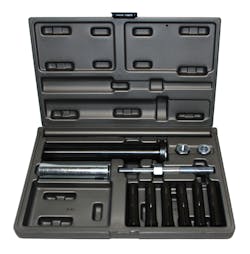There are many complications technicians run into when removing fasteners. Whether they are screws, bolts or studs, fasteners can become corroded, react with other materials or just simply become stuck from being overtightened. When any of these occurs and a technician attempts to remove the fastener, it will often prove impossible using common tools. The head of a bolt could become stripped and rounded so that a wrench or socket can’t get a grip on it. Or a stud could be seized in place and removing it by normal means is unsuccessful. No matter the case, trapped fasteners are a relatively common occurrence in automotive shops, and tools that can offer a reliable and quick solution would be seen as valuable to any technician.
Rescuing trapped fasteners
One fastener issue that is particularly common in areas of the country that receive snowfall -- and therefore road salt -- is corroded hex head screws and bolts. When these types of fasteners rust, two things can happen: the fastener can become trapped, or the head can become rounded making it so that a wrench or traditional socket will slip and not be able to turn the fastener. In many cases, the former leads to latter.
“We see a lot of rounding, corrosion, rust on these fasteners, which causes a traditional socket -- a six point or 12 point socket -- not to work at removing that fastener,” says Jarrett Wolf, product manager at GEARWRENCH. “This requires the technician to find a solution to get that stuck fastener out.”
Current solutions
While there are solutions on the market today, they are often difficult to use and may present multiple drawbacks.
“Solutions that are out there today … require [technicians] to take an extraction socket and literally pound it onto a damaged fastener,” Wolf says. “A lot of technicians are fearful of using a hammer or mallet to pound on a fastener because when you’re using that you can hit something fragile, especially when working in a tight confined space. You see quite often that these extraction sockets are not just used under the hood, but also inside the car under the dash or in other confined areas.”
When the fastener extractor is pounded onto the head of the trapped fastener, it bites into the metal of the fastener to allow the technician to remove the stuck item. Each time the tool is used, however, it is aggressively worn down, to the point where it may need to be replaced frequently.
“That causes the socket to wear out quickly and lose its gripping ability after a few cycles,” Wolf says. “A common pain point is a user will say ‘I’ve used this a couple dozen times and it’s already useless to me.’”
Once the extractor tool has been pounded onto the fastener and the fastener has been successfully removed, the two are now stuck together, and the technician has another job of getting them apart.
“[Technicians] would now have to either try to pound out that fastener, or many times they were even heat treating that socket, which damages the integrity of the socket,” Wolf says. “So it created more work.”
Once the technician is eventually able to get the tool and the fastener apart, they may find that the damaged fastener is a specialty item, such as an unusually long bolt, and a replacement part needs to be ordered from the OE, slowing or delaying the repair process.
A final issue technicians may have with the current extraction solutions is that when fastener heads get corroded or stripped, they may wear down to a size that traditional sockets won’t fit.
“Say you started out with a 14mm fastener,” Wolf explains. “Over time that 14mm fastener has worn down, so let’s say maybe it’s a 13.5mm now. With a traditional extraction socket [set], they might not have a size that fits.”
New solutions
This sets the stage for tool dealers to introduce technicians to alternative solutions to these problems that could potentially present simpler resolutions. One such tool is the GEARWRENCH Rescue Extraction Sockets. These sockets, available in late 2018 or early 2019, present methods of extracting corroded or damaged fasteners different to most of the tools on the market today.
“Rather than being pounded onto the fastener, it simply slides onto the fastener, hugging it instead of cutting into it,” Wolf says.
This resolves the issue of technicians being worried about hammering a tool in confined spaces or near fragile equipment. It also prevents premature wear of the socket, since it doesn’t cut into the fastener to provide grip. In addition, it can make the process of removing the fastener from the socket quicker.
“Being that it’s tapered and it hugs the fastener rather than cutting into it, it’s much easier to disengage it from that fastener, saving another step, another process that [technicians] don’t have to do,” Wolf says.
The Rescue Extraction Sockets also have some helpful features, such as the bi-directional design. This allows the sockets to be used in removing stuck extractors, and also tightening them in case a technician needs to reuse a specialty fastener when a replacement part is not readily available.
These sockets also address the problem of not being able to find a socket that fits stripped or corroded fastener heads, by providing what GEARWRENCH calls “minus sizes.”
“They’re almost half sizes of sockets, to better fit a damaged fastener,” Wolf says. “No matter what kind of fastener you have in the range of these sockets, we’re guaranteed to have a socket to still take it out.”
Removing non-threaded fasteners
Another problem technicians may encounter is an unthreaded stud or dowel that has become stuck and is not easily removable using normal methods. Many times, these types of fasteners may even break off as technicians attempt to remove them. Technicians may think that the only way to remove this type of fastener is by beating it or using a slide hammer, which doesn’t fit easily in tight spaces.
Fortunately, there are tools that allow the extraction of these fasteners without the use of a slide hammer. Tools such as the Cal-Van In-Line Dowel Puller set, No. 95400, use a series of collets to pull the fastener out in a straight line with little effort.
“You would put that [collet] around the fastener and drop a sleeve over the top of that, and tighten that piece into the sleeve,” says Matt Kenny, vice president of sales and marketing at Cal-Van Tools. “What it does is, it closes that collet down around the fastener. Then you put the bigger black sleeve over it, and use just a regular wrench to extract it in a straight line without having to hammer it, beat it or anything like that.”
This allows for much smaller clearance than a slide hammer, allowing for fastener extraction in tighter workspaces. Kenny also notes that the set includes sizes for virtually any fastener on medium duty vehicles and smaller.
Making the sale
Being well-versed on how these tools work is a good idea when presenting them to technicians.
It can also help to explain that these tools may be simple and easy solutions to otherwise frustrating problems. The savings in time, frustration and physical effort alone are likely enough to make tool sets like these worth the investment for many technicians.
About the Author
David Brierley
Editor | Fleet Maintenance
David Brierley is the editor of Fleet Maintenance magazine.
Brierley’s education and career have been based in the publishing industry. He is an award-winning writer and comes from a background in automotive, trucking, and heavy equipment. Brierley joined the Endeavor Business Media vehicle repair group in 2017 as managing editor for Fleet Maintenance, PTEN, and Professional Distributor magazines, as well as VehicleServicePros.com. In his current role, he writes for and oversees production of Fleet Maintenance magazine. He has worked in the publishing industry since 2011.

